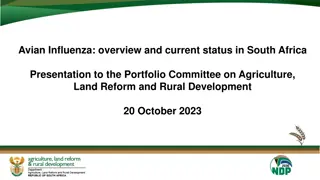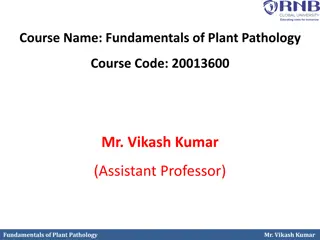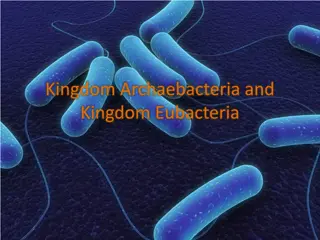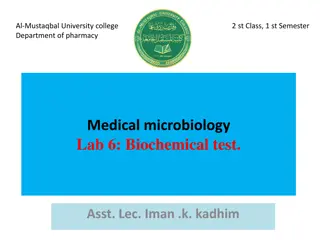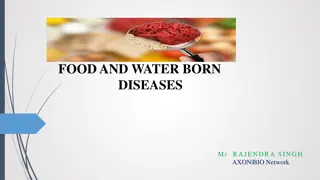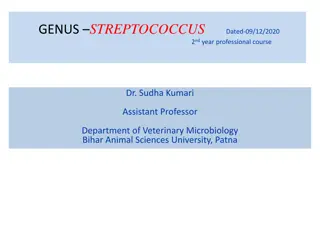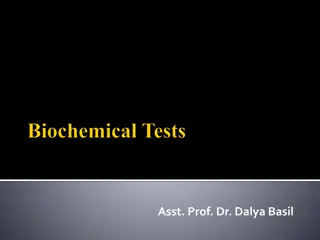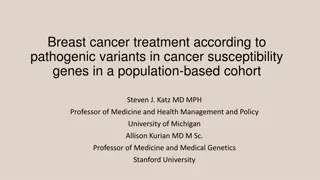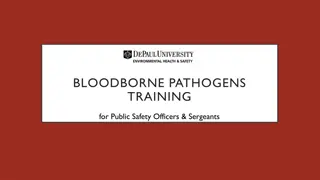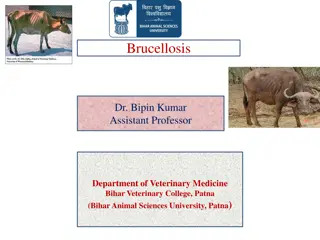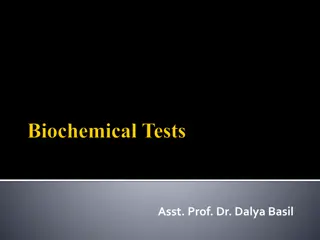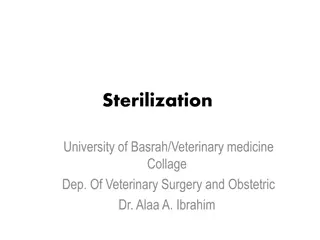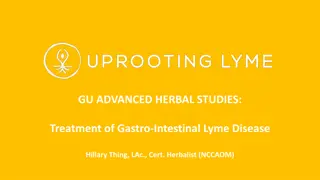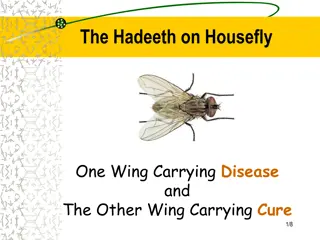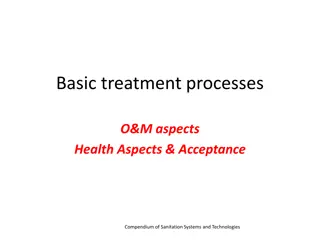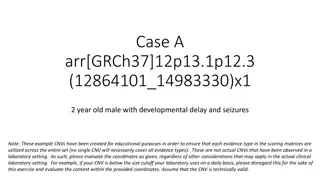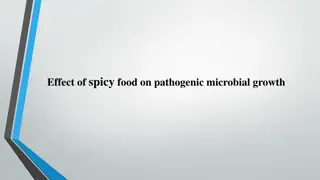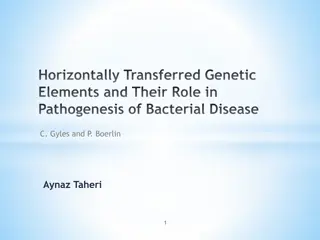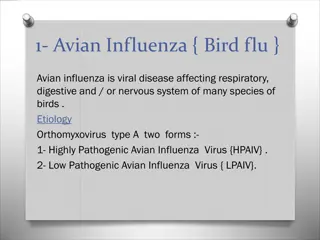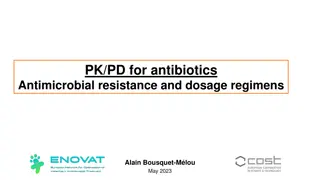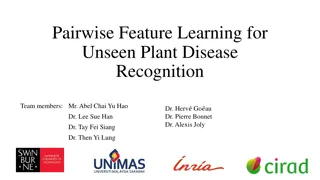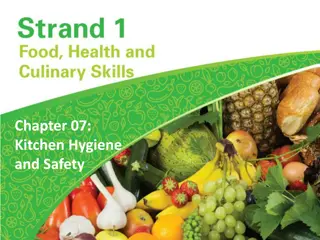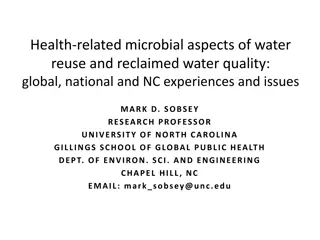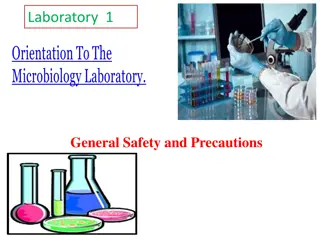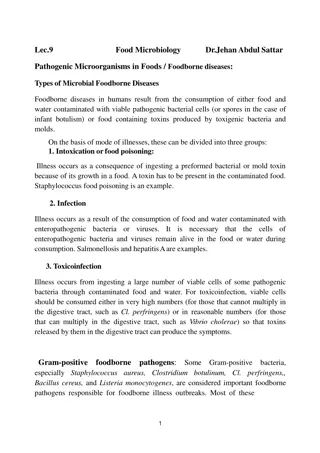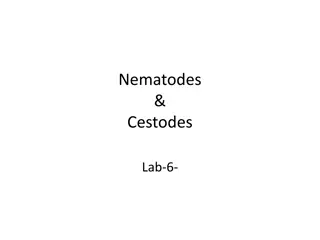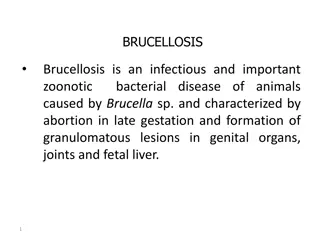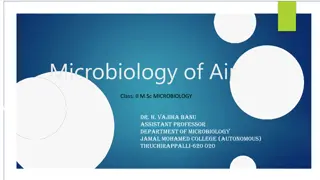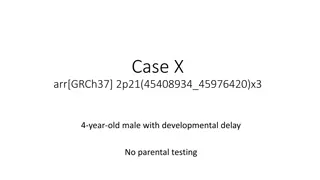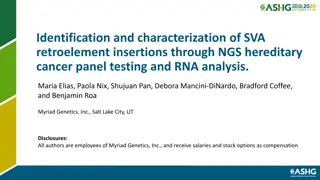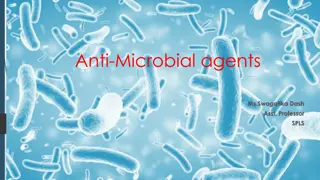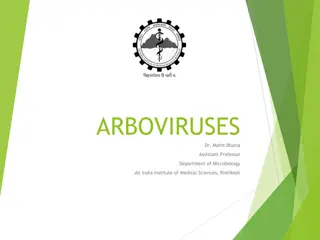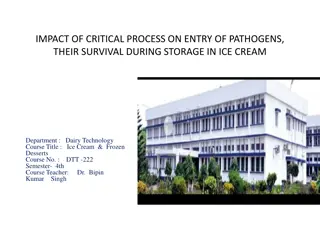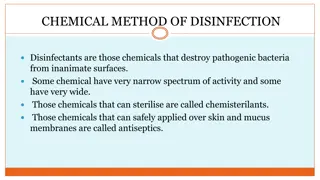Impact of Highly Pathogenic Avian Influenza 2023 on South African Broiler Industry
The presentation by the South African Poultry Association sheds light on the detrimental effects of Highly Pathogenic Avian Influenza (HPAI) on the broiler industry in South Africa. Factors such as load shedding, water supply interruptions, and now, the outbreak of H7N6, have exacerbated the financi
4 views • 19 slides
Avian Influenza Overview and Outbreak History in South Africa
Avian Influenza, specifically Highly Pathogenic Avian Influenza (HPAI) outbreaks in South Africa, have been documented since 2004, affecting primarily ostriches and poultry. Wild bird transmission remains a concern, with risk factors such as rainfall, temperature, wetlands, and poultry movements con
2 views • 25 slides
Fundamentals of Plant Pathology with Mr. Vikash Kumar - Course Overview and Important Pathogens
This course with Mr. Vikash Kumar covers the fundamentals of plant pathology, including identification of diseases, pathogen nature, disease management strategies, and principles. Learn about important plant pathogenic organisms such as fungi, bacteria, and fastidious vascular bacteria, along with s
0 views • 12 slides
Contrasting Kingdoms: Archaebacteria vs Eubacteria
Archaebacteria and Eubacteria are two distinct kingdoms of bacteria with unique characteristics. Archaebacteria, originating from Ancient Greek, are ancient organisms thriving in extreme conditions without peptidoglycan in their cell walls, while Eubacteria, the most common bacteria, have peptidogly
0 views • 11 slides
Microbiology Lab Tests for Identifying Bacterial Pathogens
Learn about key biochemical tests like the Coagulase Test, Catalase Test, and Oxidase Test used in medical microbiology to identify pathogenic bacteria such as Staphylococcus aureus. Understand the methods, significance, and interpretation of results for each test.
6 views • 17 slides
Food and Water-Borne Diseases: Causes and Classification
Food and water-borne diseases, caused by contaminated food or water, lead to acute illnesses. These diseases are classified into food-borne infections and food-borne intoxications. Food-borne infections, triggered by pathogenic microorganisms, can be fungal, bacterial, viral, or parasitic, with long
3 views • 57 slides
Overview of Streptococcus Bacteria and Classification
Streptococcus is a genus of gram-positive bacteria commonly found on skin and mucous membranes. It includes pathogenic and non-pathogenic species, with cell division along a single axis forming pairs or chains. The bacteria were first observed by Billroth and named by Ogston. Different types of stre
1 views • 28 slides
Coagulase Test in Microbiology
The Coagulase test is a crucial microbiological method used to differentiate Staphylococcus aureus (Coagulase Positive) from other Staphylococci (Coagulase Negative). By detecting the presence of the enzyme coagulase, this test helps identify pathogenic strains of Staphylococcus that can cause serio
3 views • 28 slides
Breast Cancer Genetic Variants and Treatment Guidelines
Recent research highlights the importance of genetic testing for cancer susceptibility genes in breast cancer patients to guide personalized treatment plans. Guidelines based on pathogenic variants in genes like BRCA1, BRCA2, and others provide insights on relative cancer risks and recommendations f
0 views • 21 slides
Bloodborne Pathogens Training for Public Safety Officers & Sergeants
Bloodborne pathogens (BBPs) are pathogenic microorganisms found in human blood that can cause diseases like HIV, Hepatitis B, and Hepatitis C. Public safety officers and sergeants face occupational exposure to BBPs and should follow OSHA's BBP Standard to protect themselves. Training, vaccinations,
0 views • 41 slides
Brucellosis: A Zoonotic Disease Impacting Animals and Humans
Brucellosis, caused by the genus Brucella, is a zoonotic disease affecting animals like goats, sheep, cattle, and humans. It is primarily transmitted through contact with infected animals or ingestion of their products. The disease manifests in various forms like Mediterranean fever and can lead to
0 views • 13 slides
Coagulase Test in Microbiology
Coagulase test is a crucial microbiological technique used to differentiate Staphylococcus aureus, which produces coagulase, from other species like S. epidermis and S. saprophyticus that do not. This test helps in identifying the presence of bound and free forms of coagulase, aiding in the accurate
0 views • 56 slides
Overview of Brucella Bacteria and Brucellosis Infection
Brucella bacteria are Gram-negative coccobacilli associated with Brucellosis, a disease causing flu-like symptoms in humans. They exhibit specific characteristics, differential tests, and antigenic structures. Infection occurs through various sources like milk, meat, and contact with infected animal
0 views • 13 slides
Foodborne Illness: Causes and Symptoms
Foodborne illnesses are diseases transmitted to humans through contaminated food, causing symptoms like nausea, vomiting, stomach cramps, fever, and diarrhea. These illnesses are mainly caused by pathogenic microorganisms such as bacteria, viruses, and parasites, often spread through mishandling of
0 views • 10 slides
Guidelines on Sterilization, Disinfection, and Types of Disinfectants in Veterinary Medicine
Sterilization is the process of eliminating all microorganisms from an object, while disinfection reduces the number of pathogenic microorganisms on surfaces. Various types of disinfectants exist, including high-level, intermediate-level, and low-level options. Different equipment items in veterinar
0 views • 18 slides
Advanced Herbal Approaches for Gastro-Intestinal Lyme Disease Treatment
Unveil the symptoms, stealth pathogenic gut infections, differentiation from typical GI diseases, causes of GI disorders, and post-natal Qi tonification in addressing Gastrointestinal Lyme Disease using advanced herbal studies. Learn to differentiate infectious GI diseases, identify potential causes
0 views • 38 slides
Scientific Study on Houseflies and Disease Prevention
Prophet Muhammad's teaching on houseflies carrying both disease and cure sparked a scientific study led by a student research team at Qassim University. The study demonstrated that submerging houseflies in water can inhibit the growth of pathogenic bacteria, potentially leading to the extraction of
0 views • 8 slides
Export Controls at UW-Madison
Export controls at UW-Madison are U.S. laws regulating the export of information, goods, and services, including research activities involving foreign persons. Violations can lead to severe penalties. The laws may apply to scenarios like research with pathogenic materials, satellite research, and fo
2 views • 14 slides
Operation and Maintenance Aspects of Sanitation Systems
Maintenance of basic treatment processes, settlers, and anaerobic baffled reactors (ABR) is crucial for efficient functioning. Regular sludge removal, careful handling of pathogenic organisms, and monitoring scum levels are essential tasks. Anaerobic systems like ABR require a start-up period and sp
0 views • 32 slides
Comprehensive Assessment of a Pathogenic CNV in a 2-Year-Old Male with Developmental Delay and Seizures
In this case study, a 2-year-old male presenting with developmental delay and seizures was evaluated for a CNV at the 12p13.1p12.3 region. The CNV was found to overlap with the GRIN2B gene, a known haploinsufficient gene associated with developmental disorders. Despite potential additional scoring c
0 views • 17 slides
Overview of Amoebae: Parasitic and Free-Living Varieties
Various types of amoebae, including parasitic Entamoeba histolytica and harmless commensal amoebae, are discussed in terms of their morphology, epidemiology, pathogenesis, clinical presentation, diagnosis, treatment, and habitats, such as the large intestine and water sources. Pathogenic free-living
0 views • 9 slides
Effects of Spicy Foods on Pathogenic Microbial Growth: A Study on Rosemary and Clove
Spicy foods like rosemary and clove have shown potential in inhibiting pathogenic microbial growth, which can help enhance food safety by reducing the need for chemical additives. This study explores the antimicrobial effects of these spices using microbial strains like Pseudomonas Fluorescens and S
0 views • 14 slides
Mechanisms and Role of Horizontally Transferred Genetic Elements in Bacterial Disease Pathogenesis
This presentation explores the transfer of foreign DNA into bacteria, discussing mechanisms such as conjugation, transduction, and transformation. It delves into the significance of Mobile Genetic Elements (MGEs) like plasmids, bacteriophages, and transposons in bacterial virulence and pathogenesis.
0 views • 20 slides
Avian Influenza: Symptoms, Diagnosis, and Prevention
Avian influenza, or bird flu, is a viral disease affecting birds' respiratory, digestive, and nervous systems. It presents in two forms - Highly Pathogenic Avian Influenza Virus (HPAIV) and Low Pathogenic Avian Influenza Virus (LPAIV). The virus has two important surface antigens, Hemagglutinin (H)
0 views • 7 slides
Optimizing Antibiotic Therapy for Pathogenic Bacteria and Resistance
Understanding the pharmacokinetic/pharmacodynamic relationships in antibiotic therapy is crucial for maximizing effectiveness against bacteria while minimizing resistance. Different bacterial loads and stages of infection require tailored dosing regimens to achieve optimal outcomes. Monitoring antim
0 views • 35 slides
Pairwise Feature Learning for Unseen Plant Disease Recognition
Plant diseases pose a significant threat to agricultural production, often caused by pathogenic organisms. This project focuses on pairwise feature learning for the recognition of unseen plant diseases. The research aims to design a model that can effectively classify both seen and unseen compositio
0 views • 11 slides
Kitchen Hygiene and Food Safety
Kitchen hygiene and food safety are crucial to prevent food spoilage and food poisoning. Factors like enzymes, micro-organisms, and oxygen can lead to food spoilage, while food poisoning occurs when pathogenic bacteria multiply in consumed food. Practicing proper hygiene, storage, and preparation me
0 views • 27 slides
Health Risks in Reclaimed Water and Water Reuse
Exploring the microbial aspects of reclaimed water and wastewater reuse is crucial for public health. Pathogenic microorganisms present in wastewater, such as bacteria, viruses, and parasites, can lead to gastrointestinal and systemic illnesses in humans. Proper removal and inactivation of these pat
0 views • 25 slides
Overview of Bovine Viral Diarrhea Virus (BVDV)
Bovine Viral Diarrhea Virus (BVDV) is an RNA virus belonging to the Pestivirus genus in the Flaviviridae family. It is classified into BVDV-1 and BVDV-2 genotypes with distinct biotypes. BVDV is a significant infectious disease in the livestock industry worldwide, with high prevalence and clinical c
0 views • 14 slides
Laboratory General Safety and Precautions
Microbiology involves the study of microorganisms such as bacteria, fungi, viruses, and parasites. It is crucial to maintain strict safety protocols in the laboratory to prevent contamination and ensure the well-being of individuals handling these potentially pathogenic organisms. Rules like wearing
0 views • 26 slides
Foodborne Diseases and Pathogenic Microorganisms in Foods
Foodborne diseases in humans are caused by consuming contaminated food or water containing pathogenic microorganisms or toxins. These diseases can be categorized into intoxication, infection, and toxicoinfection, each with distinct modes of illness. Pathogens like Staphylococcus aureus, Clostridium
0 views • 5 slides
Parasitic Worms: Nematodes and Cestodes Overview
Explore the world of parasitic worms with a focus on Nematodes and Cestodes. Learn about Wuchereria bancrofti causing lymphatic filariasis and Echinococcus species leading to hydatid disease. Discover the transmission, laboratory diagnosis, treatment, and clinical aspects associated with these patho
0 views • 12 slides
Brucellosis: Causes, Transmission, and Control
Brucellosis is an infectious zoonotic bacterial disease affecting animals, characterized by abortion and granulomatous lesions. It is caused by Brucella species and has a rich history of discovery. The disease has multiple species with varying pathogenic strains and vaccines. Brucellosis has resista
0 views • 24 slides
Importance of Aero-Microbiology in Understanding Airborne Diseases
Aero-microbiology focuses on studying living microbes suspended in the air, with a particular emphasis on sources of microorganisms in the atmosphere. Airborne transmission of diseases through droplets and infectious dust is explored, highlighting the risks and factors affecting pathogenic microorga
1 views • 22 slides
Case Study: 2p21 Duplication in a 4-Year-Old Male with Developmental Delay
This case study involves a 4-year-old male with developmental delay and a duplication in the 2p21 region. The genetic analysis indicates no parental testing has been done, and the duplication has been reported as LP/VUS (Likely Pathogenic / Variant of Uncertain Significance). Predicted genes and int
0 views • 16 slides
Identification and Characterization of SVA Retroelement Insertions in Hereditary Cancer Panels
SVA retroelement insertions, specifically SINE-VNTR-ALU (SVA) types, were examined through Next Generation Sequencing (NGS) and RNA analysis in hereditary cancer panel testing. Twelve unique SVA retroelements were identified in genes like APC, BRCA1, CHEK2, and others, with variant interpretations r
0 views • 6 slides
Anti-Microbial Agents and Their Applications
Anti-microbial agents, including antiseptics, disinfectants, and germicides, play a crucial role in preventing infections and promoting public health. They can inhibit the growth of pathogenic micro-organisms on living tissues, objects, and materials. Sterilization ensures complete destruction of al
0 views • 16 slides
Arboviruses: A Comprehensive Overview of Arthropod-Borne Viruses
Arboviruses, transmitted by bloodsucking arthropods, are a diverse group of RNA viruses with varied classifications like Togaviridae, Flaviviridae, Bunyaviridae, Reoviridae, and Rhabdoviridae. In India, Dengue, Chikungunya, and Japanese Encephalitis are prevalent arboviruses. Togaviridae, including
0 views • 70 slides
Impact of Critical Process on Pathogen Entry and Survival in Ice Cream Manufacturing
The critical processes in ice cream manufacturing, such as pasteurization, homogenization, and chilling, play a crucial role in reducing pathogens and microorganisms, ensuring product safety. Pasteurization at specific temperatures and times effectively eliminates pathogenic organisms, while homogen
0 views • 9 slides
Chemical Methods of Disinfection in Healthcare
Disinfectants play a crucial role in eliminating pathogenic bacteria from surfaces in healthcare settings. They come in various forms with different spectra of activity. This article delves into the classification of disinfectants, their spectrum of activity, properties required for chemical agents,
0 views • 14 slides

